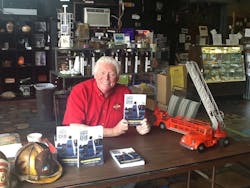September is more like the start of a New Year than January. Maybe it’s the back-to-school activities, but it’s time to get back to business after summer’s long days. For the fire service, September brings us back to reality with September 11th anniversaries, the preparation for Fire Prevention Week and the National Fallen Firefighters Foundation’s Memorial Weekend.
Over Labor Day I finished reading Dr. Burton Clark’s book, I Can’t Save You, But I Will Die Trying. After 45 years in the fire service, the title of the book is also Clark’s conclusion on the American Fire Service culture.
If you have not read one of Burt’s articles or heard one of his lectures, let me give you a warning: Burt Clark does his homework, approaches a topic thoroughly and pointedly tells you what he has learned and why you need to know. Even in his printed word, you can hear Burt’s articulate, confident voice.
I first heard Dr. Clark many years ago at one of the fire conferences. I admit I was a bit intimated by his tall stature, articulate tone and his pursuit of higher education. Like most of his presentations, Clark questions beloved fire service traditions nor is he afraid to challenge the culture and bravado of the fire service. Even the most seasoned, die-hard leatherhead must admit Clark makes them think.
In a presentation in 2012, Clark stated, “Comparing a firefighter death to soldier’s is an insult to the soldier.” He explained how the purpose of the military is to kill the enemy and defend their country while the fire service is about saving lives. Killed in Action (KIA) and Died of Wounds (DOW) terms refer to death as a result of hostile action in military service. Clark observes that “Using the term LODD (line of duty death) perpetuates the myth that firefighters’ getting killed is part of the job.”
Controversial? You bet and that’s the sort of dialog that Clark believes the fire service must continue to do. He supports his arguments with historical data and new research that when a firefighter dies, something went wrong and could have been prevented.
I admit I am a great fan of Burt Clark and will not forget one encounter at the National Fire Academy (NFA). Myself and another were heading for the path to the log cabin at the NFA. Burt stopped and offered us a ride to the cabin. We got in the backseat. The car didn’t move. We waited. Finally, Burt turned around and said, “Well?” Blank looks. “Buckle your seat belts!” he roared. Oops.
I look forward his presentations because he challenges traditional thinking and stirs up discussions. He is not afraid to make bold statements such as in 2005 when he wrote, “We Killed Firefighter Brian Hunton,” an unbelted Amarillo, Texas, firefighter who fatally fell out of a fire truck. A man of action, Clark subsequently started the “Seatbelt Pledge” to get one million firefighter’s signatures pledging to wear their seatbelts.
Get a copy of I Can’t Save You, But I Will Die Trying, read it and then leave it on the kitchen table in the firehouse. Let Clark’s words stir some discussions that need to be stirred. September is a good time to talk about prevention, safety and why it’s important that everyone goes home.






